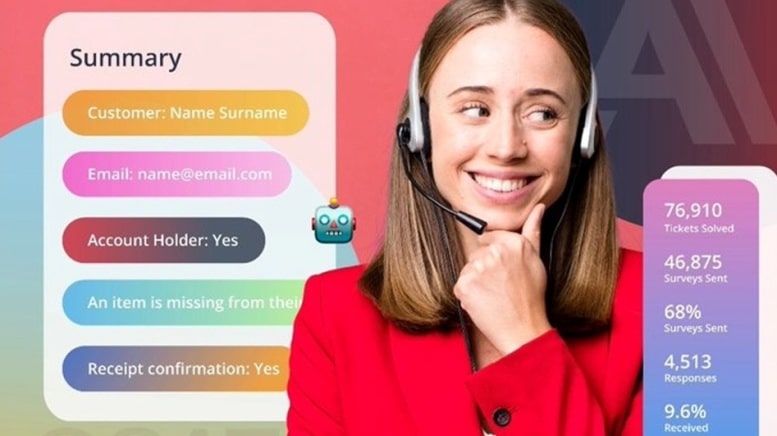What is Conversational Analytics and Why is It So Powerful for Transforming Your CX in your contact centre? – Ventrica explains
If you want to know what you’re doing right or wrong in your business, your customers are the best people to ask. That’s why companies spend a fortune on market research, focus groups, and customer surveys.
Not too long ago, someone came up with the idea that the best time to ask customers about their experience was immediately after an interaction. And so, the post-call survey was born, which measures NPS (Net Promoter Score) or CSAT (Customer Satisfaction).
While that indicates, via a score, how well you’re connecting with customers, it doesn’t give deep insights. It doesn’t tell you why customers feel the way they do. You would have to interview them to find that out, which is a costly exercise.
Isn’t there an easier way?
Well, it turns out that thanks to the wonders of AI (artificial intelligence), there is. All the information you could want to know about your customers is locked up inside the data collected from their interactions with your company.
This comes in many forms, including the metadata trail when they interact with you online, the transactional data showing their purchase history, and the recordings and transcripts of their voice and non-voice interactions with your customer-facing staff.
Before the advent of cloud computing and AI, storing that much data, transcribing it accurately, and then analysing it was impossible. Now it is.
By meticulously analysing interaction data across all channels, you can uncover detailed insights into customers’ needs, attitudes, preferences, and behaviours. Armed with this intelligence, you can better understand what you’re doing right as a business and what you’re doing wrong so that you can improve your products, offers, and service.
A game-changing technology

The key to unlocking the insight held in those interactions is a technology called Conversational Analytics. There are two slightly different variations of the technology. One ‘listens’ to interactions as they happen in real-time to make recommendations to the agent. The second transcribes and analyses past interactions to uncover insights into customer behaviour, agent performance and operational efficiency.
Both are built on the backs of several of the most important recent technological developments:
Cloud computing: Only the cloud has the endless storage capacity to keep hundreds of thousands or millions of recordings and transcriptions of customer interactions and the processing grunt to run the algorithms capable of analysing them.
Natural Language Processing (NLP): A Machine Learning technique capable of ‘understanding’ language to convert speech to text, analyse words for their sentiment, and extract topics from texts. This is the critical technology required for understanding the content and emotional tone of customer conversations.
Speech Recognition: By transcribing spoken words into text using machine learning and NLP techniques, it becomes possible to analyse conversations and uncover insights that would otherwise remain inaccessible.
Intent Recognition: One of the first things transcripts are analysed for is to understand the customer’s intentions, which enables them to be guided toward the most appropriate resource for handling their query efficiently and effectively.
Entity Recognition: Machine learning’s ability to identify named entities (such as products or companies) in conversations is invaluable for tracking customers’ sentiments and preferences.
Topic Modelling: Analysis, particularly of a large number of interactions, can quickly identify recurring themes in customer conversations. Organisations can then use this information to refine their approach to customer service, develop new offerings, personalise customer experiences, and create new training material.
Sentiment Analysis: One of the cornerstones of AI-powered analytics is its uncanny ability to detect emotions in conversations, both through words and tone of voice. It’s essential for assessing customer satisfaction and understanding what actions to take next.
Anomaly Detection: Machine learning algorithms excel at spotting patterns and identifying when something breaks the usual pattern. This can be crucial to detecting and preventing things like fraud and even customer churn.
Predictive Modelling: Leveraging the data from past interactions to predict future behaviours means machine learning can be used to help create targeted marketing strategies, promotions, and service improvement programmes.
The incredible uses of Conversational Analytics

Thanks to the cloud and the various AI technologies above, it’s almost trivial to have 100% of customer interactions checked and scored for quality and compliance. Beyond those traditional operational-focused objectives, much more information and insight into customer interactions can now be teased out to help improve customer experience and optimise business operations. Here are some key areas where conversational analytics shines:
Gaining deeper customer insights: By analysing vast amounts of data, conversational analytics uncovers patterns, trends and sentiments that might go unnoticed. These invaluable insights grant businesses a greater understanding of their customers’ needs, preferences, and pain points.
Improving customer satisfaction: Equipped with this more profound understanding of customers, businesses can proactively address concerns and issues before they escalate. Taking a proactive approach to customers often prevents them from churning and creates a more positive relationship. Conversational analytics empowers contact centre agents to do this by personalising interactions, offering more appropriate solutions more promptly, and resolving problems more quickly.
Optimising agent performance: Through the analysis of agents’ interactions with customers, conversational analytics can help supervisors and trainers identify areas for improvement. Analytics can even give real-time feedback to agents so they can refine their approach mid-interaction.
Personalising the customer journey: With more information on customers, businesses can tailor interactions specifically for individuals, making each interaction unique. By accounting for customer preferences and previous interactions, companies can provide recommendations to suggest relevant products and services and create a more engaging and enjoyable customer journey.
Enhancing operational efficiency: Businesses can identify areas where efficiency gains can be made by analysing all interactions. For example, it should be possible to pinpoint why customers are put on hold or other bottlenecks that cost time and money and drag down the customer experience.
Proactive issue resolution: Analytics can even give businesses the almost mystical power to address problems sometimes before they happen, but at least before they escalate too far. Once a company has identified patterns and trends in its customer interaction data, it can take proactive measures to prevent those things from happening.
Predictive analytics and forecasting: This is another AI-gifted superpower, but this time we are identifying broader trends that tell the business abound consumer behaviour on a broader scale so it can understand where its market, in general, is headed. This can be invaluable for planning marketing campaigns, developing new offers, and allocating resources effectively.
Identifying compliance and security risks: By analysing customer interactions to look for specific keywords and phrases related to sensitive topics, businesses can ensure they comply with their industry’s regulations, safeguard customer data, and prevent fraud. For example, the appearance of specific phrases (or the lack of them) could indicate that either an employee or customer is attempting (or omitting) something they should not. This reduces the risk of fines and other penalties and helps establish customer trust and confidence.
Dynamic scripting: Most contact centres deploy scripts or workflows to give agents a trail to follow through the branching maze of all the possible interaction types they might come across. Throw real-time analytics into the mix, and those scripts can adapt dynamically based on customers’ responses to suggest alternative approaches or prompt the agent to make specific offers, improving upsell and cross-sell opportunities.
Adoption of Conversational Analytics in contact centres

Contact Babel’s recent Customer Interaction Analytics Guide surveyed hundreds of contact centre leaders to discover how they were applying the technology. As you can see from the graph below, 56% of respondents find real-time analytics useful for handling unhappy customers. Sentiment analysis, as we know, easily picks out unhappy customers, and either the agent can be prompted to take action right away or follow-up recovery activities can be put in action.
Almost half find it helpful for compliance. Again, non-compliance issues, such as an agent missing an important question or statement, can be flagged in real-time or addressed afterwards.
Source: Contact Babel’s Customer Interaction Analytics Guide
Given its many proven uses and the fact that it enables all customer interactions to be monitored at a fraction of what it used to cost to check a handful of them, it’s no surprise that Conversational Analytics is one of the fastest-growing technologies in the contact centre.
Its ability to decipher the complexities of human language and translate these into actionable insights means Conversational Analytics is rapidly becoming a cornerstone of modern customer experience strategies and a vital tool for improving quality, compliance and efficiency across the business.

The company is headquartered in Southend, where it operates from spacious, hi-tech and modern offices, placing significant emphasis on its staff’s comfort and well-being. Ventrica shares the same passion for its customers’ business as it does for its own and continually strives for quality and service delivery consistency.
For additional information on Ventrica view their Company Profile






